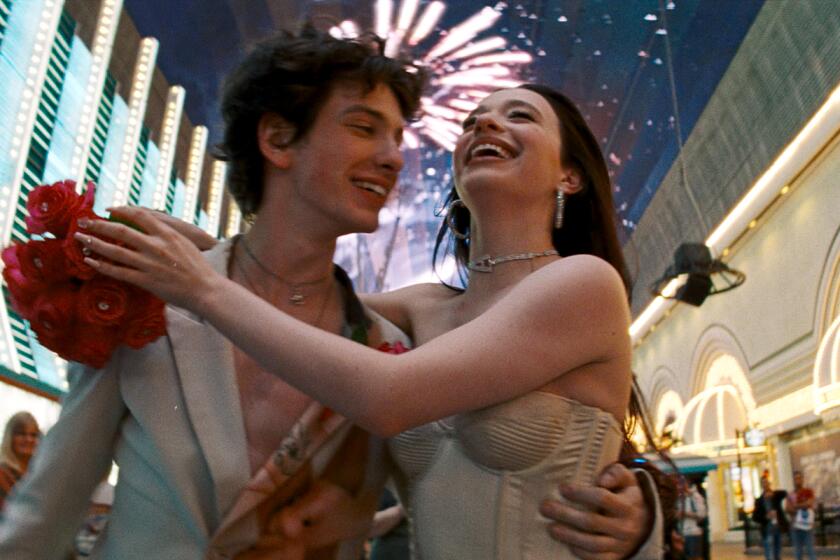CABARET REVIEW : Jim Bailey, the Master Illusionist
- Share via
The best drag queens have always made an extravagant show of plumping up the icons of their affections, such as Katharine Hepburn, Joan Crawford, Bette Davis, Tallulah Bankhead and Carol Channing, and then standing aside to turn out those images in gaudy camp display, as though they were there to outdo the originals.
Jim Bailey walks a finer line. So fine, in fact, that his exacting replication of a small repertoire of great ladies, Streisand, Judy Garland and Peggy Lee, takes him beyond the drag genre and into one of the central enigmas of our time, particularly as raised by Barry Humphries’ Dame Edna Everage and the movies “Paris Is Burning” and of course “The Crying Game”--the question of what constitutes sexual identity.
Bailey is appearing at the Roosevelt Hotel’s Cinegrill this week, having opened as Peggy Lee on Tuesday and Wednesday, then playing Barbra Streisand tonight and Friday, and finishing with Judy Garland on Saturday. If the normal frisson of watching a female impersonator is to know that within the costumes and makeup and lights and attitudes there’s basically a man at work, however self-repudiating, Bailey takes his act to another level where it’s the illusion that’s paramount, not the semi-transparent sexual disguise.
Bailey doesn’t use his high-profile viragoes for pent-up gay comic relief (which can be a hoot when done by Charles Pierce or Randy Allen). In fact, none of his women are very funny, which can throw you off-balance if you’re expecting a fusillade of campy zingers. He thinks of himself as an actor (in conversation he compares himself to Hal Holbrook doing Mark Twain). What he is, really, is a miniaturist who has worked himself up to full-scale, and with such an exactitude that he has taken his act to Carnegie Hall and the London Palladium. With him, the frisson isn’t about sex at all, but about celebrity style.
In a way, this is virtual reality performance. He’s spoken about playing women who are no longer around--or in the case of Lee, fit enough--to concertize for themselves (though rumor has it that Streisand is poised for a reprise of her singing career). So a man or a woman of a certain age might have been both thrilled and spooked to stumble into the Cinegrill to see Peggy Lee in a fluffy canary-yellow gown, with De Kooning lips, charred eyeliner, high forehead and corn-silk hair, evoke the piquancy of their youth and romance in popular song.
Younger visitors would know what it was like to hear one of America’s great saloon singers who was once right up there with Sinatra in her ability to swing in front of a big band, or get up close and personal to evoke the feeling of being alone and sleepless in the middle of the night, and missing the one who got away.
And hearing songs that had seeped into the American cultural vernacular as one of its enduring forms of poetry, impervious to the unending revisionism of Top 40 charts. Brave, bluesy, melancholy, spirited numbers such as “Just for a Thrill” or “Hey, Big Spender” or “It Never Entered My Mind” or “Is That All There Is?”
Bailey has Lee’s physical moves down, the suggestion of minimalist Southern languor, the diminutive twist to bump a lyric along, hands pulling a note apart like taffy. And he’s a precise vocalist: You hear Lee’s dry laconic open notes, her soft consonants, the sport she made of bending lines into quarter-tones, like a horn player.
Jack LeComte plays drums, John Smith is on bass, and Sean Gulf is the pianist for Bailey’s act, which in Peggy Lee’s case, ended without a show-stopping climax--much in keeping with her easygoing style.
On a pure performance level, the show is a treat. But Bailey’s air-tight idolatrousness shuts out the sense of play we want to feel about the intellectual daring of one sex crossing into another, or of sexual relativity, or even what it means to be audience for one illusion serving another.
It’s of course unfair to ask something of an artist that he has no intention of addressing. Still, you find yourself hoping for more. Bailey has been doing these women for 20 years, and the age of the eye, augmented by telecommunication and the hands-off visual eroticism heightened by AIDS, has caught up with him. On a performance level as fine as his, you hope for something more interpretive and less a show of exquisite surrender. Illusion isn’t everything, after all.
* Performances at 9 nightly through Saturday at 7000 Hollywood Blvd., (213) 466-7000.
More to Read
The biggest entertainment stories
Get our big stories about Hollywood, film, television, music, arts, culture and more right in your inbox as soon as they publish.
You may occasionally receive promotional content from the Los Angeles Times.










